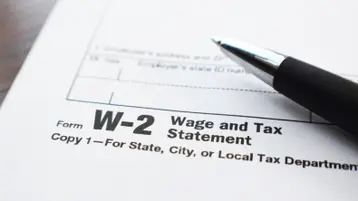
Table of contents
- 1.Types of W-2 mistakes
- 2.When to use Form W-2c
- 3.10 tips for completing Form W-2c
- 4.Conclusion
A new year is upon us, which means it’s time for W-2 processing. As you likely know, the IRS has detailed requirements for completing Form W-2. Further, the Social Security Administration (SSA) has specific deadlines for when W-2s should be filed with the agency and delivered to employees. Specifically, you must fill out a Form W-2 for every employee to whom you paid $600 or more during the tax year. This rule stands, regardless of your business size. You must also file each W-2 with the SSA and give employees their copy of the form no later than January 31. But to err is human. So, what should you do if you discover a W-2 error? First, know that W-2 errors are highly fixable, so there’s no reason to panic. Next, we’ll go over the different types of W-2 mistakes. Then, we’ll discuss when and how to resolve those errors via a corrected Form W-2, also called “Form W-2c.”
Types of W-2 mistakes
According to the IRS, the most common W-2 errors include:
- Omitting decimal points and cents from dollar amounts
- Putting dollar signs in “money” boxes
- Failing to properly format employees’ name in box “e”
- Entering the wrong employer identification number, or listing the employee’s Social Security Number as the EIN
- Using print that is too large or too small. The IRS recommends 12-point Courier font
- Erroneously checking the “Retirement plan” slot in box 13
- Not making entries visible enough. Only black ink is allowed
- Failing to use the official W-2 form. The red-inked copy on the IRS website is for informational purposes only
Other W-2 errors:
- Wrong amount of federal, state, and/or local taxable wages
- Incorrect federal, state, and/or local taxes withheld
- Inaccurate employee name, address, and/or SSN
- Improper coding for box 12
- Inaccurate Social Security tips or allocated tips
- Incorrect tax year
When to use Form W-2c
Although Form W-2c is appropriate for fixing many W-2 mistakes, not all W-2 blunders require a W-2c. You can use Form W-2c to correct these errors:
- Inaccurate employee name, address, or SSN
- Incorrect EIN
- Incorrect wages or tax withholdings
- Wrong tax year
- You reported 2 W-2s for an employee under the same EIN, but only 1 should have been reported
- You reported 2 W-2s for an employee under the same EIN, but only 1 is incorrect
- If you’ve already given the employee their W-2 copy, but haven’t filed the form with the SSA. Instead, check the “Void” box on Copy A of the incorrect W-2. Then, create a new W-2 with the appropriate information. Write “CORRECTED” on the employee’s copy of the new W-2; give this “CORRECTED” copy to the employee. File Copy A of the new W-2 with the SSA, but do not write “CORRECTED” on the SSA’s copy
- To report back pay. Instead, review IRS Publication 957 for instructions on reporting back pay to the SSA
10 tips for completing Form W-2c
Tip #1:Make sure you’re using the official IRS Form W-2c. You can order W-2s and W-2cs from the IRS online or by calling the agency. Or you can buy them from an external authorized seller, such as a major office supply store.
Tip #2:If you outsource payroll processing, including W-2 administration, your payroll provider is likely responsible for obtaining W-2 forms and handling W-2 preparation, distribution, and corrections.
Tip #3:If you perform W-2 processing in-house, review the IRS’ General Instructions for Forms W-2 and W-3, which include the following 3 sections for rectifying W-2 errors:
- General instructions, such as when and how to file Form W-2c (and Form W-3c — the transmittal form)
- Special situations, such as correcting only the employee’s name and/or SSN, inaccurate tax year or EIN, or more than 1 W-2 for the same employee
- Specific instructions, such as how to complete each W-2c box
The instructions vary, according to the type of error.
Tip #4:Note the situations where a W-2c is optional. For example, if the W-2 reflects the wrong employee address, but everything else is accurate and you’ve already filed the W-2 with the SSA, you can make the correction in one of three ways:
- Give the employee a new Form W-2 with the correct address. Write “REISSUED STATEMENT” on the new copies, but do not file Copy A with the SSA
- Furnish a Form W-2c to the employee showing the right address in box “i”, but do not file Copy A of the W-2c with the SSA
- Put the W-2 with the incorrect address in an envelope displaying the correct address and deliver it to the employee
Of those 3 alternatives, only #2 requires a W-2c.
Tip #5:You can make changes to state or local W-2 information on Form W-2c. But if those are your only changes, do not file the W-2c with the SSA. Instead, file the W-2c with the state or local administering agency (based on their reporting requirements) and give the employee their copy.
Tip #6:If you’re not sure a W-2c is the right approach for resolving a W-2 error, or if you need clarification on the IRS’ instructions, seek expert advice. Remember, the goal of the W-2c is to repair the issue, not to create another faux pas.
Tip #7:Don’t forget to send Form W-3c, which is a summary of all the W-2cs being sent, with your W-2c submission. If the W-2cs are for different tax years, file a separate W-3c for each tax year.
Tip #8:File the W-2c and furnish a copy to the employee as soon as possible after detecting the W-2 error. The SSA recommends that employers file W-2s and W-2cs online to save time and help improve accuracy.
Tip 9:Try to prepare and furnish W-2s early, prior to the January 31 deadline. This may help you promptly catch and remedy W-2 problems.
Tip #10:Do not ignore W-2 mistakes. If an employee brings the issue to your attention and you fail to address it, they can lodge a complaint against you to the IRS. You can face penalties for not filing a correct and timely W-2. Example: For filings due Dec. 31, 2019, the penalty is $50 per Form W-2 filed correctly within 30 days of the deadline, up to the maximum penalty for the year ($194,500 for small businesses). The maximum penalty for not filing a corrected W-2 at all is $270 per form. You can avoid the penalty if the error is “inconsequential” or if you can show “reasonable cause.”
Conclusion
The information on your employees’ Form W-2 impacts their federal and applicable state or local tax returns. Therefore, the data needs to be precise. If the employee has already filed their returns by the time you issue a corrected W-2, depending on the type of error, they may need to amend their return. You, as well, may need to amend your business’ employment tax returns.

Grace Ferguson
Table of contents
- 1.Types of W-2 mistakes
- 2.When to use Form W-2c
- 3.10 tips for completing Form W-2c
- 4.Conclusion






